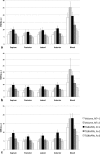Accelerated cardiac magnetic resonance imaging in the mouse using an eight-channel array at 9.4 Tesla
- PMID: 20740650
- PMCID: PMC3021721
- DOI: 10.1002/mrm.22605
Accelerated cardiac magnetic resonance imaging in the mouse using an eight-channel array at 9.4 Tesla
Abstract
MRI has become an important tool to noninvasively assess global and regional cardiac function, infarct size, or myocardial blood flow in surgically or genetically modified mouse models of human heart disease. Constraints on scan time due to sensitivity to general anesthesia in hemodynamically compromised mice frequently limit the number of parameters available in one imaging session. Parallel imaging techniques to reduce acquisition times require coil arrays, which are technically challenging to design at ultrahigh magnetic field strengths. This work validates the use of an eight-channel volume phased-array coil for cardiac MRI in mice at 9.4 T. Two- and three-dimensional sequences were combined with parallel imaging techniques and used to quantify global cardiac function, T(1)-relaxation times and infarct sizes. Furthermore, the rapid acquisition of functional cine-data allowed for the first time in mice measurement of left-ventricular peak filling and ejection rates under intravenous infusion of dobutamine. The results demonstrate that a threefold accelerated data acquisition is generally feasible without compromising the accuracy of the results. This strategy may eventually pave the way for routine, multiparametric phenotyping of mouse hearts in vivo within one imaging session of tolerable duration.
© 2010 Wiley-Liss, Inc.
Figures








Similar articles
-
Design, evaluation and application of an eight channel transmit/receive coil array for cardiac MRI at 7.0 T.Eur J Radiol. 2013 May;82(5):752-9. doi: 10.1016/j.ejrad.2011.08.002. Epub 2011 Sep 14. Eur J Radiol. 2013. PMID: 21920683
-
Two-dimensional sixteen channel transmit/receive coil array for cardiac MRI at 7.0 T: design, evaluation, and application.J Magn Reson Imaging. 2012 Oct;36(4):847-57. doi: 10.1002/jmri.23724. Epub 2012 Jun 15. J Magn Reson Imaging. 2012. PMID: 22706727 Free PMC article.
-
Towards a five-minute comprehensive cardiac MR examination using highly accelerated parallel imaging with a 32-element coil array: feasibility and initial comparative evaluation.J Magn Reson Imaging. 2013 Jul;38(1):180-8. doi: 10.1002/jmri.23955. Epub 2012 Nov 29. J Magn Reson Imaging. 2013. PMID: 23197471 Free PMC article.
-
32-channel phased-array receive with asymmetric birdcage transmit coil for hyperpolarized xenon-129 lung imaging.Magn Reson Med. 2013 Aug;70(2):576-83. doi: 10.1002/mrm.24482. Epub 2012 Nov 6. Magn Reson Med. 2013. PMID: 23132336 Free PMC article.
-
Modular 32-channel transceiver coil array for cardiac MRI at 7.0T.Magn Reson Med. 2014 Jul;72(1):276-90. doi: 10.1002/mrm.24903. Epub 2013 Jul 31. Magn Reson Med. 2014. PMID: 23904404
Cited by
-
Comparison of gross pathology inspection and 9.4 T magnetic resonance imaging in the evaluation of radiofrequency ablation lesions in the left ventricle of the swine heart.Front Physiol. 2022 Oct 19;13:834328. doi: 10.3389/fphys.2022.834328. eCollection 2022. Front Physiol. 2022. PMID: 36338496 Free PMC article.
-
Application of kt-BLAST acceleration to reduce cardiac MR imaging time in healthy and infarcted mice.MAGMA. 2014 Jun;27(3):201-10. doi: 10.1007/s10334-013-0392-5. Epub 2013 Jul 9. MAGMA. 2014. PMID: 23836162 Free PMC article.
-
Cell autonomous role of iASPP deficiency in causing cardiocutaneous disorders.Cell Death Differ. 2018 Jul;25(7):1289-1303. doi: 10.1038/s41418-017-0039-6. Epub 2018 Jan 19. Cell Death Differ. 2018. PMID: 29352264 Free PMC article.
-
Cardiovascular magnetic resonance imaging for sequential assessment of cardiac fibrosis in mice: technical advancements and reverse translation.Am J Physiol Heart Circ Physiol. 2024 Jan 1;326(1):H1-H24. doi: 10.1152/ajpheart.00437.2023. Epub 2023 Nov 3. Am J Physiol Heart Circ Physiol. 2024. PMID: 37921664 Free PMC article. Review.
-
Development of Real-Time Magnetic Resonance Imaging of Mouse Hearts at 9.4 Tesla--Simulations and First Application.IEEE Trans Med Imaging. 2016 Mar;35(3):912-20. doi: 10.1109/TMI.2015.2501832. Epub 2015 Nov 19. IEEE Trans Med Imaging. 2016. PMID: 26595913 Free PMC article.
References
-
- Streif JU, Herold V, Szimtenings M, Lanz TE, Nahrendorf M, Wiesmann F, Rommel E, Haase A. In vivo time-resolved quantitative motion mapping of the murine myocardium with phase contrast MRI. Magn Reson Med. 2003;49:315–321. - PubMed
-
- Herold V, Morchel P, Faber C, Rommel E, Haase A, Jakob PM. In vivo quantitative three-dimensional motion mapping of the murine myocardium with PC-MRI at 17.6 T. Magn Reson Med. 2006;55:1058–1064. - PubMed
-
- Epstein FH, Yang Z, Gilson WD, Berr SS, Kramer CM, French BA. MR tagging early after myocardial infarction in mice demonstrates contractile dysfunction in adjacent and remote regions. Magn Reson Med. 2002;48:399–403. - PubMed
-
- Gilson WD, Yang Z, French BA, Epstein FH. Measurement of myocardial mechanics in mice before and after infarction using multislice displacement-encoded MRI with 3D motion encoding. Am J Physiol Heart Circ Physiol. 2005;288:H1491–H1497. - PubMed
-
- Kober F, Iltis I, Cozzone PJ, Bernard M. Myocardial blood flow mapping in mice using high-resolution spin labeling magnetic resonance imaging: influence of ketamine/xylazine and isoflurane anesthesia. Magn Reson Med. 2005;53:601–606. - PubMed
Publication types
MeSH terms
Grants and funding
LinkOut - more resources
Full Text Sources

